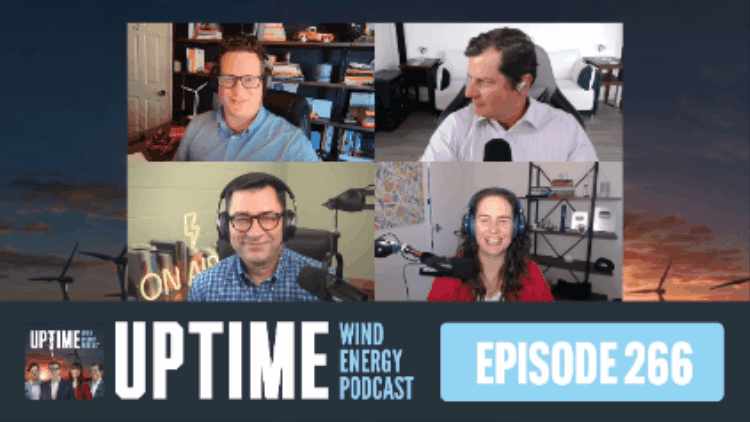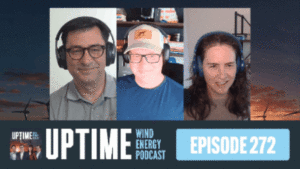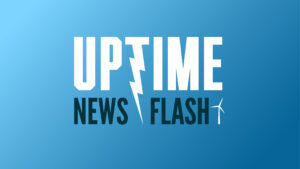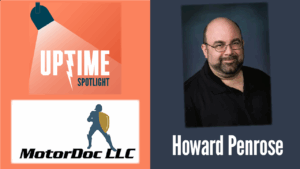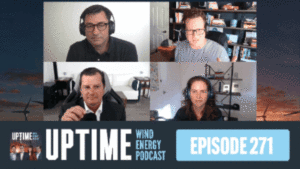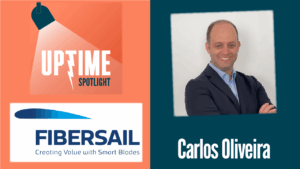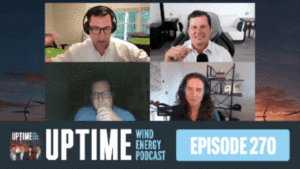Podcast: Play in new window | Download
This week we discuss a $5 million investment in a wind worker training center in Australia, challenges faced by RWE’s US offshore wind projects due to recent policy changes, and the recent power blackout in Spain. Plus an article from PES Wind Magazine about cybersecurity in wind energy.
Sign up now for Uptime Tech News, our weekly email update on all things wind technology. This episode is sponsored by Weather Guard Lightning Tech. Learn more about Weather Guard’s StrikeTape Wind Turbine LPS retrofit. Follow the show on Facebook, YouTube, Twitter, Linkedin and visit Weather Guard on the web. And subscribe to Rosemary Barnes’ YouTube channel here. Have a question we can answer on the show? Email us!
You are listening to the Uptime Wind Energy Podcast brought to you by build turbines.com. Learn, train, and be a part of the Clean Energy Revolution. Visit build turbines.com today. Now here’s your hosts, Allen Hall, Joel Saxum, Phil Totaro, and Rosemary Barnes.
Allen Hall: Down in Victoria, Australia. They’re investing about 5 million Australian dollars to establish a wind worker training center, which is focused on developing technical skills for both onshore and offshore wind energy roles.
And the initiative is looking to create a skill workforce pipeline for all the wind projects that are happening down in Australia. This is a really unique. Program, uh, Rosemary, just because Victoria is looking to have about 67,000 workers in energy by 2040 and they think they need about 4,000, [00:01:00] uh, people to work construction for onshore wind at about 2,500 data for offshore wind.
That’s a sizable number of people, but Victoria is headed towards 95% renewable generation by 2035. So you’re gonna need to build a workforce pretty quickly. $5 million for a training center is a good first start. Is it enough though?
Rosemary Barnes: Yeah, I mean, they need to have a first step I guess. I mean, not that it’s the first step, there’s already a lot of, a lot of workers in the state.
Um, but I mean, for sure Victorian needs more, needs more service technicians and yeah, a bunch of other, other workers. I mean there’s also still a lot of new wind farms being built, so there’s that as well. It’s also not just Victoria, you know, all around. Um, there was quite a lot of going on in Queensland, although the future plans have, I think been, um.
Uh, toned down a lot because the government changed. Um, south Australia also has, uh, still got, oh, it’s got a lot of wind, already got a lot of plans to build [00:02:00] more. Um, and yeah, there’s new renewable energy zones that are, you know, hopefully coming on, maybe even offshore wind starting in the next five years or so.
So yeah, if you want to, you know, suddenly expand your industry, then you do need to think a few years ahead. Um, otherwise you’re gonna end up. With a big, a big crunch. Everyone wanting to build a project at the same time. And also, you know, a lot of wind farms. Uh. Getting past that first, you know, like the first few years where not too much maintenance is needed.
Um, there’s a lot more things that can go wrong in the, you know, middle to end of a wind farm’s life. And we’re seeing a lot of that, especially in Victoria where they had most of the early wind farms in Australia. So I definitely think it’s timely and uh, hopefully this one’s successful. And, uh, yeah, we’ve got an election coming up.
Probably will have already happened by the time this episode’s released. We’ve got a federal election. There has not been a whole lot of talk about renewable energy actually. Um, and especially the jobs that are created by Renewal Energy, especially wind, you know, like it’s a, it’s a [00:03:00] downside of the technology that it needs maintenance, but it’s a real upside in terms of that, you know, a lot of maintenance means a lot of maintenance jobs, and these are good jobs.
I hope that, yeah, by the time we have our next election, people can, um, be talking a bit more about what we need to really turbocharge the, um, rollout of renewables in Australia. This will be a good
Joel Saxum: first step. I think there’s a couple interesting things about, interesting things about that is right before we went down to Wind Australia, we were talking to a lot of people involved in that industry and uh, I did talk with an ISP that was a part of this.
They were, uh, advising, kind of like partnering with the university that’s putting this thing together because they noticed a, a gap, right? And one of the gaps when we talking, like again, talking with some of the people down there was. Uh, they want a workforce, right? They want people in there, so, but you need people to transition over from other jobs or come in because it’s hard to have, because of local content laws, and correct me if I’m wrong here, Rosemary, you can’t really, or [00:04:00] it’s a lot easier to use local talent than it is to bring other people in.
You can’t really just rely on a, a migrant workforce or, you know, you can’t bring people in from Europe every year to do all the maintenance. You really kind of need to have that local talent.
Rosemary Barnes: Yeah, I mean, I don’t think that Australia has particularly strong, um, we don’t have many local content laws at all.
Um, but then in terms of. Labor. Yeah. Like most countries, you just, not just anybody can come in and just start working in Australia, you need permission. And, um, you know, there’s caps on the, the number of visas of that kind that are allowed. Definitely. Um, there are people coming over from Europe constantly to work here.
It’s a long, it’s a long way. Um, I don’t think that it’s so much about the laws in Australia being unusual as it is just that sheer number of people that are needed and the logistics of actually getting. Enough people to make a meaningful difference. Um, coming over from Europe, I, I mean, think about it.
Would you want to go [00:05:00] somewhere, um, for three months away from, you know, your family and, uh, friends and act activities, anything like that? Definitely in the longer term, much better too. Um, yeah, develop, develop the workforce. And I mean, as much as, you know, I, I love that the, um, wages are high in, in the industry because, you know, I’m in the industry and I enjoy that.
But, uh, if we have a lot more workers, like enough workers, then the prices will start to go down a bit more. And like the cost of labor, I. Is a big thing in, um, you know, how much wind farms are spending, are maintaining, uh, operating and maintaining their wind farms is, you know, like it’s a lot more than it is in other countries.
And I think that a lot of that is because of the high cost of labor here for, for that specific type of role. But I mean, that also does mean that right now, like if you get in early, that’s a, a really, really great industry to move into because you’re probably going to. More, it’s very satisfying work as well.
You, you know, like it’s, it’s really good to, you know, there’s a wind tur, a wind turbine, [00:06:00] it was offline because, you know, something was wrong and hey, I helped fix it. And now it’s online generating clean electricity. That’s, I find that incredibly satisfying to be part of that. It’s really, you know, tangible things.
So I’m hopeful that, um, yeah, more training centers like this that we will start to see the workforce expand, uh, quite quickly.
Allen Hall: If you haven’t opened the recent edition of PES Win, you need to do that. You can visit ps win.com and download the uh, the. Electronic version of the magazine or you can put in a request, again a paper copy and you will want to get that paper copy ’cause it is an elegant magazine full of information.
So this quarter there’s an article from Cyber G and Joel and I have been talking about cybersecurity to a lot of operators all over the world. It is a huge topic right now and uh, in that article it does go on to say like, 1% of the win assets have. Adequate cybersecurity protection. And Joel, there are days that question [00:07:00] that’s even 1% on some of the farms we’ve been around.
And the SCADA systems are the open door, uh, that needs to be closed. There’s a lot going on in Europe, much more in Europe than there is in the United States. The European Union has that network and information system directive two, NIST two. You hear people say, NIST two, I need a NIST two. Uh, that requires that they have reports, cybersecurity incidents.
Have some transparency on what’s happening. They actually can deal with it. Uh, this cyber energy article is good and another alarm to the industry, like, Hey, in times when things get a little slow. We gotta clean up and, and take care of the, of some of these entry points into these turbines and these wind
Joel Saxum: farms.
Well, I think that you like, like anything, you follow the money, right? And if you watch the insurance markets, you’re starting to see cyber, cyber attack, cyber security insurance being a new product that’s coming into almost all of these brokers. So that’s the thing that’s happening. It’s a known issue.
Right. I [00:08:00] wanna highlight one of the projects that’s being done here in the United States is there is a bank of turbines. If you have a product or a solution that you want to test for cybersecurity, and they’re testing SCADA systems, it’s in involved with one of the, uh, national labs. Very cool project.
Just get a hold of Alan and I, we can give you some details on that. Um, but yeah, I mean, as cybersecurity goes, you’re seeing Europe, they’re on the, you know, there. There’s a, there’s a conflict happening right out their back door. So this may hit a little bit closer to home to them, but we’ve had things hit our, our grid as well here in the states in the last few years.
So, um, if you haven’t addressed some of these things, I think it’s, it’s, it’s high time that people do and cyber energy, it can help you out. They have a product called
Allen Hall: Sentry, C-E-N-T-R-Y. Get it Century instead of an assets at c. So it’s, it’s a, it’s a protection platform. It’s pretty slick, right? It’s a real time monitor of the wind assets and it’s providing the protection that a lot of wind operators need.
So if you are interested in cybersecurity and, [00:09:00] uh, pretty much every operator around the world should be at this point, you, you wanna look at cyber energy as website and check them out, or just go visit. Uh, PES win.com. Read the article and find out all the details.
Joel Saxum: As busy wind energy professionals, staying informed is crucial, and let’s face it difficult.
That’s why the Uptime podcast recommends PES WIN Magazine. I. PES Wind offers a diverse range of in-depth articles and expert insights that dive into the most pressing issues facing our energy future. Whether you’re an industry veteran or new to wind, PES Wind has the high quality content you need.
Don’t miss out. Visit ps wind.com today.
Allen Hall: Well, Spain had a large power blackout, including Portugal and, and parts of France for a little while, and Spain’s grid operator is denying that the situation was caused by the dependences on solar power mostly. And most of Spain was shut down for several hours, like north of 12 [00:10:00] hours.
This is, uh, sort of a problem for renewable because if you go online on LinkedIn, or if you, you go on Twitter, one of those social media sites you see a lot about, oh, renewable energy causes problem. Yeah, yeah, yeah, yeah. So let’s just go to some of the details. We do know at this point, at the grid, at that moment was, uh, operating it at about 50% solar.
And about 10% wind and about another 15% for nuclear and gas. Uh, and they right now, they think there were maybe two separate incidences in southwestern Spain at substations that created the incident. Now. It looks like it was a frequency variation was the cause of the shutdown. I saw some things on LinkedIn.
Of course, your source for all news lately is that the, the frequency varied and you can actually measure that up in Lafayette, which is a [00:11:00] long ways from Spain. So that frequency variation when it occurs in one place does transmit all over the grid in Europe. And frequency variation is a huge problem because that the system is designed.
For one frequency, 50 hertz, and all the equipment is designed particularly for that. So as you vary off of that, the loss is increased. You can have a lot of bad things happen. So there are safety mechanisms in place to disconnect if the frequency or vari frequency variation is to. Big and it looks like it was.
Um, and as Rosemary has pointed out in some of your videos, the way you fix that is you have synchronous condensers on the grid, which are, rosemary me, can describe what a synchronous condenser is
Rosemary Barnes: to take back a step. What traditional. Electricity grid with a lot of thermal generation, uh, in it. What, what it behaves like is, you know, these traditional thermal generators are really big and really heavy and they’re spinning.
They’ve got a lot of inertia, right? It is actually really [00:12:00] physically hard to slow them down or speed them up suddenly. So it kind of acts as a natural. Um, damper on the system. When the frequency gets out of whack, then all of this spitting mass just naturally helps to, um, keep it stable. So if you have a lot less of that, you can either, uh, because you don’t have a lot of thermal generators online, then you can either replace it with.
More spinning mass, which is what a synchronous condenser is. It’s basically like a generator, but, um, instead of spinning it up by burning something and you know, making steam to spin it, you spin it using electricity instead. So it’s still a big spinning mass and you can put a few of those in. It’s certainly not the case that you can’t have a high renewables, um, penetration system.
That, uh, doesn’t have sufficient inertia. I understand that they had about 80% renewables, uh, in the grid at the time that of the disturbance. That is not an abnormally high amount. Like it’s definitely far from record breaking. Um, there [00:13:00] was a, yeah, um, some, something weird happening with frequency oscillations and I don’t know why.
You know, obviously the Spanish grid deals with frequency variations all the time and has a mechanism to, um. You know, address that. I don’t know the specifics of that or why it didn’t go right, but that would be one factor. Another thing was that there was a lot of solar power that, um, suddenly tripped off shortly before the blackout.
So that would be another destabilizing event, but again, it’s not unique to, um, to renewables. Um, and then there was another thing that happened early on was that the. An interconnection between Spain and France, um, which I believe was, uh, at least a couple of gigawatts. I’m not sure exactly the size, but in, in the gigawatts range that tripped off.
And then that makes it harder if Spain say, Spain has to all of a sudden act as an island, or Spain and Portugal have to act as an island. Um, so, you know, it’s hard to say that was a cause or [00:14:00] effect. Um, and then after a few of those things had happened, then generators in Spain started tripping and going off, and so there was just no, um.
There was nothing there to con control the system. So obviously, you know, like they did have, yeah, like maybe up to 20% of their generation was from these big spinning, um, masses, which should be enough to keep things stable. But if they start tripping off, then they’re not providing any kind of service anymore.
So, um, you know, it, it also might be that there were some, um, settings that, you know, were not as robust as, um, they, they should have been.
Allen Hall: But in that grid, it’s really hard to model those kind of failures. I think that’s what the problem is because Texas has had something very similar. It’s actually had it multiple times if you pay attention.
They’ve had sort of, uh, a cascading series of events that pull off mostly solar. Then take down adjacent, uh, substations. And when you have so many [00:15:00] different technologies all on the same grid and you’re not sure exactly how they respond to every situation, it’s impossible to model one because the detail there would be incredible.
Two, you’re just trying to make sure everything’s playing happy all the time. And I, I, this, this is, I don’t think this is unique. I think it, the scale of it is pretty big, but Joel, when they had the ice storm down to Texas in 2022, Yuri? 21. 21, okay. So in the, the amount of Texas that was offline, which was a huge amount of Texas plus it was offline for like three days.
As they tried to figure out what was happening,
Joel Saxum: that was an extreme, like the RCA points to extreme weather event, right? Where that was a bunch of natural gas plants that, like valves froze up. They weren’t winter ice correctly, things like that. But you’re exactly correct. Like one, when things started cascading, they just started cascading big time, right?
And this went click, click, click. We, you know, we need Alan, we need Joe Shahan from [00:16:00] podge to, to, to, to, to do
Allen Hall: this. Yeah. I, yeah, he’s. He’s gonna tell you it’s complicated. That’s gonna be his response because it is, it’s really complicated.
Phil Totaro: It is. But you wanna also know what happened. I, after they had that blackout that Rosie talked about in South Australia, what did they do?
They put in energy storage. So you wanna actually fix the problem. I, if you’re not gonna see the, because the thing that we’re all talking about right now is if you’re not gonna modernize the grid to handle all those different. Types of generators being on the same thing, connected at the same time, and responding in whatever ways they’re gonna respond.
You wanna know how you, you immediately, and you know, at least somewhat cost effectively, address the situation in the shortest timeframe possible is just by putting. Grid connected storage on there that absorbs or deploys depending on what you need, um, you know, what the grid needs. And, you know, I mean, that’s, that’s the way that you can handle both short term, [00:17:00] um, you know, frequency fluctuations.
And anyway, the short answer is you wanna fix this quick, put storage on the grid. There you go.
Joel Saxum: And that’s what we’re doing. Yeah. There’s constantly records being set by, by energy storage.
Phil Totaro: The longer term fix is to modernize the grid, to accommodate all these other, you know, things. Uh, what that basically what everybody talks about.
Oh, what does modernize the grid means? It means that you need better. Energy management software and the right kind of hardware to be able to provide that kind of frequency response and balancing. So again, unless you’re going to spend the money to modernize the grid, which is necessarily gonna be more expensive than just deploying energy storage, deploying energy storage is gonna get you the quickest way of, you know, precluding.
Massive grid fluctuations and potentially blackouts from happening.
Rosemary Barnes: Yeah, I would’ve like to say though that the, um, Spanish grid hasn’t, hasn’t modernized [00:18:00] before that. I have seen the, you know, the eventual root cause analysis and, you know, there’ll be probably more information coming out in a few days and then in a few weeks, but it will probably be a year before the, you know, with the South Australia, it was it.
I think it was most of a year before, like the full list of, you know, every single thing that had to happen at the same time in order to cause the, the blackouts before that. It’s like really well known. Um, it takes, takes a lot. So it, yeah. Obviously something has gone wrong and I don’t think we know yet whether.
It was predominantly about how much renewables were in the grid because Spain frequently has a lot of renewables in the grid and, you know, has not had this problem before. So it was more, it was definitely more than just that. Um, but yeah, it will take a while for us to know, um, you know, people who are usually, you know, communicators that are similar to me in terms of.
Wanting more renewables in the system. I do see a lot of them. Their take was to immediately say, well, obviously this was nothing to do with renewables, because essentially renewables are perfect and nothing can [00:19:00] ever go wrong. That’s not the right, that’s not the right take. That’s not the path to having, you know, a hundred percent clean electricity grid to pretend that there’s no problems.
You know, when something. Goes wrong. You learn what you can from it and to do anything else is just absolutely crazy. So I, I think it’s definitely frustrating that every time a crisis like this happens, renewables get blamed and that kind of like sticks in people’s minds ’cause it’s the first thing that they hear.
And you know, like years later, lots of people still think the South Australian blackout was caused by wind energy, which I guess literally it was if you include like the energy of the wind blowing over power lines. But you know, like it’s, it’s equally wrong to say that it had nothing to do with renewables.
At this point, we don’t know, and certainly many of the weird things that happened before the blackout were related to a lot of renewables, and you need to. You need to learn from that. Otherwise, we will never get a a hundred percent clean electricity grid.
Allen Hall: Don’t let blade damage catch you off guard. OGs.
Ping sensors detect issues before they become expensive, [00:20:00] time consuming problems from ice buildup and lightning strikes to pitch misalignment and internal blade cracks. OGs Ping has you covered The cutting edge sensors are easy to install, giving you the power to stop damage before it’s too late. Visit eLog ping.com and take control of your turbine’s health today.
All right. Uh, RDB has suspended work on its US offshore wind projects In response to recent policy changes by the administration and the CEOR to B and announced the decision a ahead of the company’s annual meeting, which was just held recently. And this has caused a little bit of a ripple effect. So from what we can tell right now, and Phil’s going to give us all the details, there are three separate places that I had where Rwb is involved up in New York, down in Louisiana.
They got that plot down in Louisiana, and then obviously in California. But there may be some sites in North Carolina also, or off the coast of North
Phil Totaro: Carolina based on what. Has been [00:21:00] made public, uh, RWE themselves has said that they’ve sunk more than 1.1 billion into development cost and lease payments for the areas that they either own or co-own or, uh, what have you.
So that’s, that’s a lot of money to have put up already. Uh, to basically not have confidence in being able to move forward. Now, if we go back and review what the government said, it’s number one, they’re not doing any more lease auctions on anything that hasn’t already been done. Okay? So that’s one thing that doesn’t impact R-W-R-W-E at this point, other than, you know, they were also interested in doing projects in Maine, et cetera, et cetera.
But that’s not why they’re pulling out. What’s happened more recently is the inconsistency of the application or lack thereof of tariffs and the, uh, the note from Boem, uh, to EOR and, you know, regarding Empire [00:22:00] Wind, in which Boem is basically saying we are gonna reevaluate every single permit, uh, that’s ever been issued.
You know, regardless, I guess regardless of who’s done it. Um. Because there were actually some leases that took place and some permits that were issued during Trump’s first term. Uh, it wasn’t all just, you know, Biden administration trying to rush everything through and get it in under the wire. You know, some of these projects have been, you know, in the, the lease auction and permitting phase for.
You know, almost a decade. And, and in the case of Empire Wind, it was something like 14 years, uh, when they first started considering, um, you know, that, that, uh, lease area. So what RW is upset about is the fact that it’s just, it’s, it’s the inconsistency and the uncertainty around policy that has caused.
Them as project developers and the financiers who we’re gonna be backing them to [00:23:00] say, you know what, we’re gonna take a step back because it doesn’t look like you’re gonna be able to build this project very quickly or conveniently like you want to. And there’s also uncertainty about the power off. Take agreements.
Um. You know, if the government’s also gonna have some kind of say around, um, you know, the, the transmission infrastructure as well. So besides the, the projects, which is what everybody tends to focus on, the electrical infrastructure is also something that, you know, boem and technically the federal government, since these projects are in our, our outer continental shelf, it’s federal water, um, they have jurisdiction over some of the permitting that that goes along with.
Uh, the transmission infrastructure. And so if you can’t build a project and you’re not guaranteed to have power off, take, uh, you know, what else can you do, but hit the pause button.
Joel Saxum: Well,
Phil Totaro: I think
Joel Saxum: at the, at the end of the day, Phil, it’s just like, uh, uh, you say it often is political versus technical, right?
Because [00:24:00] that the technical argument is sound. Uh, it’s been sound for offshore wind. Uh, but politically we are, we run into a bunch of problems and the, those problems extend and extend and extend. Right now we’re talking about job creation. That was a big thing. That’s one of the, one of the big deals with the IRA bill, bringing all these things into, into the United States, like say, uh, uh, this week, uh, one of the, the articles that we have, PRIs PRIs me and cancels a, um, blade or blade, uh, cable factory for offshore wind.
So that’s, that’s a $200 million investment with how many jobs that that thing could have been. Those are good, good high paying jobs as well. Right.
Phil Totaro: But this is also part of a, a wider issue that we’ve talked about before, which is you never really had US based companies that were all that committed to the offshore wind market to begin with.
Now you’re introducing uncertainty and the people who were coming over here were the Europeans and some Asians, but. You know, mostly [00:25:00] the Europeans that wanted to, to actually plow money into the us. Now they’re, you know, going back to the, the genesis of this, which was RWE pulling up stakes. I don’t think the, they’re, they may be, you know, one of the first companies, but they’re probably not gonna be the last.
Um, and you know, you’re gonna. I mean, you can antagonize offshore wind all you like, but you’re, you’re going to find your wallets up to $75 billion lighter, um, based on doing that because, you know, in addition to the project CapEx that doesn’t get spent, as Joel just said, it’s jobs and factories that don’t get built.
That’s also tax revenue. It’s r and d investment. Um, and you know, it, it’s, it’s. Everybody, basically, everybody loses. Um, so. You know, it’s in instead of this, as I said kind of before the show, we were all kind of anticipating that, you know, the current administration was probably [00:26:00] gonna not be too friendly to offshore wind and that it would be maybe like a, a five year window of, of a downturn in the market, or at least a, a nominal leveling off of the market.
Now you’re talking about this is, has the potential to set us back 10 years because getting all these European. Investors and project developers back into the US is gonna require a heck of a lot of convincing.
Allen Hall: That’s gonna do it for this week’s Uptime Wind Energy podcast. Thanks for listening, and give us a five star rating when you can press a little button, make sure it says five stars, or don’t be a mean person.
You know what I’m saying? Five stars is good. And also check out Uptime Tech News, our substack newsletter and that thing has exploded everybody. Uh, so if you want weekly or sometimes daily content about wind energy or other, uh, random facts, you can check out. Uptime Tech News are Substack newsletter. And we’ll see you here next week on the Uptime Wind Energy [00:27:00]Podcast.



